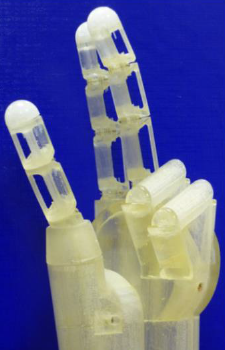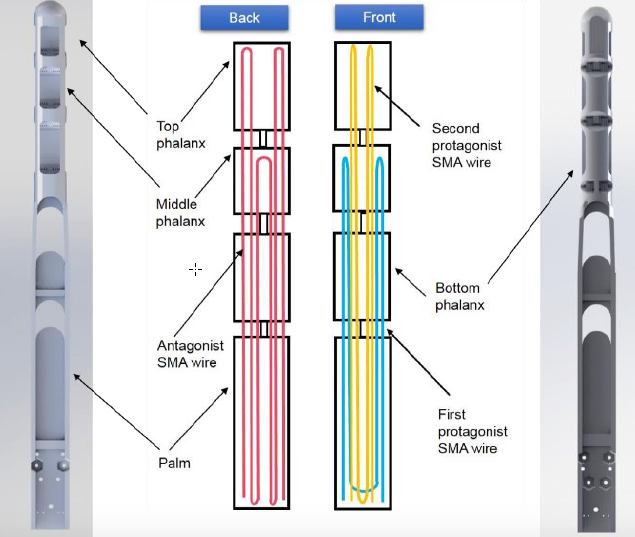An artificial hand that can respond sensitively thanks to ‘muscles’ made of shape-memory wires
April 9, 2015

Artificial hand able to respond sensitively thanks to muscles made from smart metal wires (credit: Filomena Simone et al.)
Engineers at Saarland University have created an artificial hand with muscles made from of nickel-titanium alloy shape-memory wire (the wire is able to “remember” its shape and to return to that original shape after it has been deformed).
The new technology allows for fabricating flexible, lightweight robot hands for industrial applications and novel prosthetic devices. The muscle fibers are composed of bundles of ultrafine nickel-titanium alloy wires that are able to tense and flex.
The material itself has sensory properties allowing the artificial hand to perform extremely precise movements.
“Shape-memory alloy (SMA) wires offer significant advantages over other techniques,” says research team leader Stefan Seelecke.
“Up until now, artificial hands, such as those used in industrial production lines, have relied on a lot of complex background technology. As a result they are dependent on other devices and equipment, such as electric motors or pneumatics, they tend to be heavy, relatively inflexible, at times loud, and also expensive.”
In contrast, tools fabricated with artificial muscles from SMA wire don’t require additional equipment, making them light, flexible, and highly adaptable. They operate silently and are relatively cheap to produce.
And these wires have the highest energy density of all known drive mechanisms, which enables them to perform powerful movements in restricted spaces, explains Seelecke.
Smart wires

Shape memory alloy-actuated finger diagram representing the “smart” wires inside the structure (credit: Filomena Simone et al.)
The “shape memory” feature is based on phase changes that occur within the material. If the wire becomes warm (when it conducts electricity, for example), the material transforms its lattice structure, causing it to contract like a muscle.
The Saarland engineers use “smart” wires to play the role of muscles in the artificial hand. Multiple strands of shape-memory wire connect the finger joints and act as flexor muscles on the front-side of the finger and as extensor muscles on the rear. The engineers copied the structure of natural human muscles by grouping the very fine wires into bundles to mimic muscle fibers. These bundles of wires are as fine as a thread of cotton, but have the tensile strength of a thick wire.
The use of individual wires also provide a greater surface area for heat dissipation, and the bundle of fine wires can undergo rapid contractions and extensions equivalent to those observed in human muscles, achieving fast and smooth finger movements.
Another effect of using the shape-memory metal wires is that the hand can respond in a natural manner when someone intervenes while a particular movement is being carried out. This means that humans can literally work hand-in-hand with the prototype device.
A semiconductor chip controls the relative motions of the SMA wires, allowing precise movements to be carried out, and also act as sensors.
“The controller unit is able to interpret electric resistance measurement data so that it knows the exact position of the wires at any one time,” says Seelecke. This enables the hand and the fingers to be moved with high precision.
Abstract of Design and fabrication of a three-finger prosthetic hand using SMA muscle wires
Bio-inspired hand-like gripper systems based on shape memory alloy (SMA) wire actuation have the potential to enable a number of useful applications in, e.g., the biomedical field or industrial assembly systems. The inherent high energy density makes SMA solutions a natural choice for systems with lightweight, low noise and high force requirements, such as hand prostheses or robotic systems in a human/machine environment. The focus of this research is the development, design and realization of a SMA-actuated prosthetic hand prototype with three fingers. The use of thin wires (100 μm diameter) allows for high cooling rates and therefore fast movement of each finger. Grouping several small wires mechanically in parallel allows for high force actuation. To save space and to allow for a direct transmission of the motion to each finger, the SMA wires are attached directly within each finger, across each phalanx. In this way, the contraction of the wires will allow the movement of the fingers without the use of any additional gears. Within each finger, two different bundles of wires are mounted: protagonist ones that create bending movement and the antagonist ones that enable stretching of each phalanx. The resistance change in the SMA wires is measured during actuation, which allows for monitoring of the wire stroke and potentially the gripping force without the use of additional sensors. The hand is built with modern 3D-printing technologies and its performance while grasping objects of different size and shape is experimentally investigated illustrating the usefulness of the actuator concept.